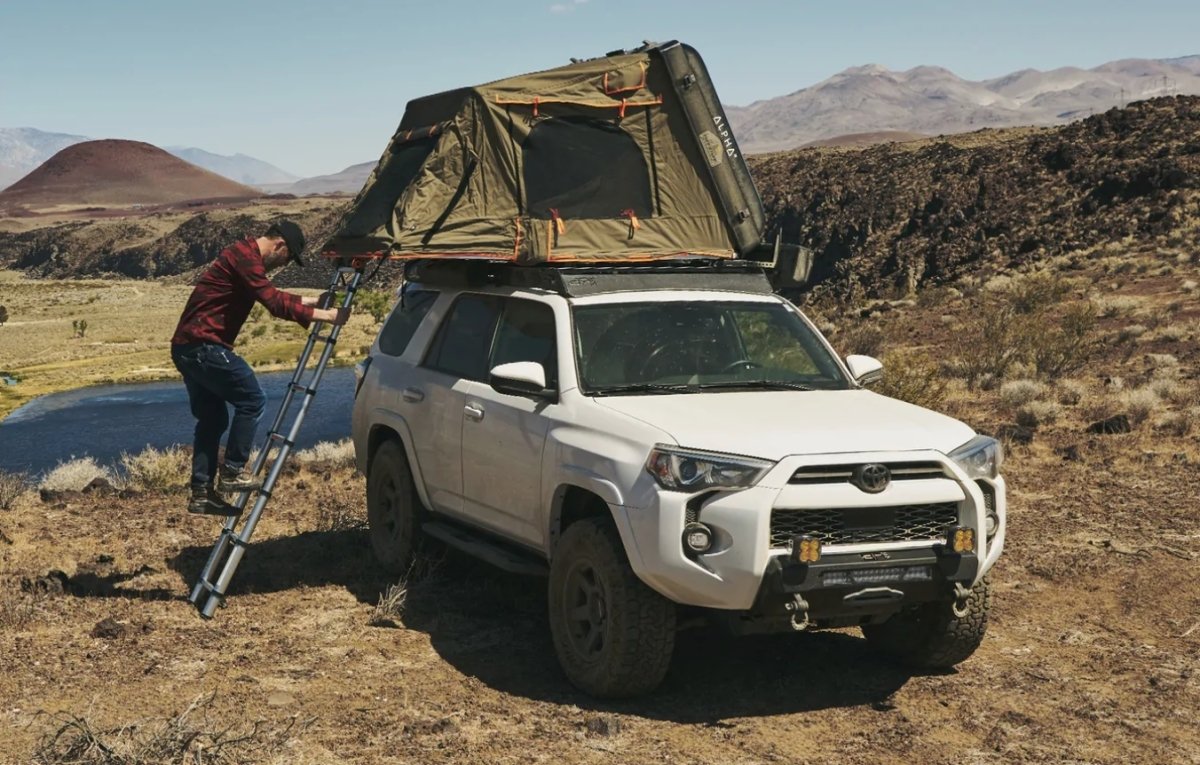As much as you enjoy taking on the activities nature has to offer with your trusty rooftop tent, there will undoubtedly come a time you have to pack up and return to normal urban lifestyle activities.
When this happens, and your rooftop tent is not in use, it is important to store it away safely until your next camping expenditure. As a rooftop tent owner with little to no information on what to do with your rooftop tent when you’re not out camping, it is easy to make many mistakes that will compromise the state of your tent.
Don’t fret. Below, we will take an in-depth look at the best ways to store your rooftop tent.
Storing Your Rooftop Tent
Since rooftop tents entered the camping scene, many campers have ditched their regular ground tents for this more convenient camping solution. With a rooftop tent latched to the roof of your vehicle, you can enjoy camping on the go more comfortably than any ground tent.
Rooftop tents are a great addition to any camping or overlanding gear, but like with any other tent, rooftop tents need to be stowed away properly when they are not in use. However, unlike many other ground camping tents that you probably shove in a bag and leave on your garage shelf, rooftop tents require a more efficient and careful storage method.
You are probably wondering why you need to store your rooftop tent in the first place. Seeing that many rooftop tents are 4-season tents and fit for all seasons, it looks like they will fair okay when left on the roof of your vehicle.
Toss in the fact that many rooftop tents come with tent covers that offer protection from external weather elements, taking your rooftop down to store them in your garage can seem stressful and unnecessary.
What makes rooftop tents great investments is that they are often made with durable, water-proof and UV-resistant materials that offer all the protection you need.
Although they are built to be durable, consistent exposure to weather elements will degrade your tent and strip it of most of its durability. Unless you plan on buying a new rooftop tent every few years, the best way to protect your investment is to take the rooftop tent down and store it properly.
Does that mean you must bring down the tent every time you take a break from camping?
Well, that depends on how long you plan to stay away from camping.
If you planned a quick family getaway to a remote location for a week or 2, it only makes sense that you should take down the tent when you get back home. In a situation like this, where the probability of you not going on another camping trip for the next few months, it only makes sense that you keep your tent safe until you need it for a subsequent family camping trip.
If you are an overland camper who is always on the go, storing your tent will be a personal judgment call. This might be especially difficult for hardcore overland campers who never miss the chance to be in nature, even in the worst weather conditions.
In this case, the best time to store your rooftop tent away is the longest period when you choose to hang up your camping boots temporarily. This will ensure you don't have to go through a stressful cycle of uninstalling and reinstalling your rooftop tents in annoyingly short periods.
Ultimately, the best time to store your rooftop tent is when you won’t need them. For campers who use 3-season rooftop tents, it is necessary to store your rooftop tent in the season they are not built for.
Is Storing Your Rooftop Tent Worth The Stress
Installing a rooftop tent is an undoubtedly stressful process. This is why for many campers, the benefits of leaving the rooftop tent installed on their vehicle outweigh that of bringing it down. Or does it?
There are many reasons why you need to store your rooftop tent properly. Some of these include:
-
It helps it last longer: Unless you plan to brave the cold on a camping trip, your rooftop tent should not be left exposed during the winter or to any moisture at all. Doing this reduces its durability and decreases the efficiency of the materials. When stored properly, rooftop tents can live their full life expectancy without a problem. Proper storage protects your investment, ensuring that it is free of degradation and other conditions that will compromise its durability.
-
Protects your finances: Storing your rooftop tent properly ensures it lasts longer, often for five to fifteen years, depending on the type of tent, materials it is made from, and the brand of tent. With a rooftop tent able to last up to a decade, you can save money on buying new tents every camping season.
-
It saves money on fuel: Leaving your rooftop tent installed on your car when it is not being used causes you to spend more on gas. This is because attaching a rooftop tent to your vehicle impacts fuel economy, causing you to use more gas for a distance than you normally would.
- Leaves it clean until your next camping trip: Storing your rooftop tent properly eliminates the need for a thorough wipedown when next you need to use your tent. Proper storage keeps your tent in good shape by keeping dust, dirt, and annoying bugs out. It also ensures your tent is stored safely away from moisture to eliminate the risk of mold growth.
How To Store Your Rooftop Tent
One major problem rooftop tent owners face when storing their tent is finding the perfect position and place to place their bulky camping gear. Seeing that the average rooftop tent weighs between 100lbs and 200lbs, the best storage position will continue to elude even a long-time rooftop tent owner.
Contrary to popular opinion, there are numerous ways you can store your rooftop safely and without a problem. With little to no information on the best ways to store their tent, it is easy to make a storage mistake that will cost you the condition of your rooftop tent.
So, where and how exactly can you store your rooftop tent?
Your rooftop tent does not require a fancy location for storage. It can be kept in the garage or your basement. Regardless of where you choose to store your tent, it is important to ensure you choose somewhere that is dry and free of moisture.
Many people make the mistake of leaving their tent on the floor. With the floor nice and dry, it is easy to get the misconception that the tent will be safe in direct contact with the floor.
Even if you cannot see physical evidence of water on your floor, it still contains small amounts of moisture that will find its way into your rooftop tent. Couple this with the moisture content in humid air, exposing your tent to a high risk of degradation.
When this happens, your rooftop tent has no means to dry. The water is left sitting on the tent, leading to damage in the form of mold (which can be dangerous to your health) and rot that is often difficult to get rid of. This puts the efficiency of your tent at risk.
So what are the best ways to store your rooftop tent?
1. Flat on the garage floor
Although we advise that you don’t store your rooftop tent directly on the floor, you can still store your rooftop tent on the floor as long as you put something between the tent and the floor. This will act as a buffer that ensures your rooftop tent does not come in contact with moisture that will compromise its durability.
Placing your rooftop tent flat on the ground is a great way to ensure it remains safe. However, this method requires a lot of space and is not ideal for garages without extra space.
How does this method work?
To store your rooftop tent flat on your garage floor, you simply need to place your rooftop tent flat as you will on the roof of your car.
- Take your rooftop tent off your car. You might need help with this part.
- Store your rooftop tent materials away in a bag.
- If you are bothered about dust and dirt getting on your rooftop tent cover, you can provide additional cover with a mattress bag. Place the rooftop tent in the bag and seal it properly to leave no room for dust.
- Set four 2by4 wood sections on the floor. Keep them about 20 inches apart to form a makeshift platform.
- Set your rooftop tent on the platform.
And that’s it! This method requires minimal effort and is an effective way to keep your tent safe. With your tent placed flat on the floor, it is easy to be tempted to use your tent as a platform to place other objects on. If you get the urge to do this, don’t! Placing objects on your tent puts it at risk of damage.
Ultimately, the spot you choose to store your tent must be level and large enough to fit the rooftop tent. Before placing your rooftop tent on the floor, ensure the tent and floor are clean.
Keep your rooftop tent away from any heat source. For double protection, place a piece of cardboard on the floor beneath the makeshift platform. When done properly, placing your rooftop tent on a platform on the floor will keep it safe until the next time you need it.
2. Lean it against a wall
This method involves placing your rooftop tent on the floor while using the wall as support. However, instead of leaving it flat on the floor, you will place the tent on its side with its flat side leaning against the wall.
The leaner technique is great for places without extra storage space. Like the flat method, the leaner technique is a safe way to store your tent, even in the winter.
To do this:
- Get a mattress bag or thick moving blankets to protect your rooftop tent. Place your tent in the bag or wrap it in the blankets. Afterward, seal the ends with duct tape.
- As with the flat storage method, you will need a makeshift platform to keep your rooftop tent off the floor. You can use four 12-inch wood sections or pool noodles. Whichever option you have will work perfectly to raise your rooftop tent off the floor.
- Place the wood or pool noodles evenly along the width of your rooftop tent.
- Place the bottom of your rooftop tent on your makeshift platform.
- Lean the tent against a wall to stabilize it.
- For added security, drill straps into the wall to hold the tent in a sturdier position.
3. The Platform
This rooftop tent storage method is an excellent option for people who do not have or need a permanent position to store their tent. Since the platform often has wheels, this method is also great for transporting your rooftop tent to and fro your vehicle.
Do you have an old cart or cart-like structure that is large enough to fit your tent? You can store your tent here! Simply seal your rooftop tent in mattress bags or blankets and place it in the cart. Keep the cart and rooftop tent swaying from overly hot or cold abs damp spaces.
4. Ceiling Storage
If you are looking for a more sophisticated rooftop tent storage solution, you should consider investing in the ceiling storage method. Although it will require that you spend more time and money preparing the storage mechanism,
As its name suggests, the ceiling storage method uses a system of pulleys and straps to suspend a rooftop tent from the roof. It eliminates the need for floor space and leaves the garage convenient.
One more advantage of this storage method is it makes it easier to lift and lower a rooftop tent from the roof of a vehicle.
Before choosing this storage method, it is essential to investigate your garage ceiling layout. Look for a wide enough space to accommodate the tent without getting in the way of other functions in your garage.
For this method, you will need electric or manual pulley systems, lifts that can hold the weight of your rooftop tent, and various other tools for the installation process.
If you can't set this system up yourself, we recommend getting a professional to handle it. This will eliminate the risks of structural or safety issues.
To use this storage method using a manual system:
- Mount harnesses, straps, or cables to the best spot in the ceiling.
- Add hooks for more support.
For the automated version:
- Place two pulleys horizontally across from each other to the width of your tent.
- Place the second pair of pulleys about 40 inches away from the previous set. Install them in the same fashion horizontally from each other.
- Install a webbing loop hook to hook to slide under your rooftop tent and lift it to the garage ceiling.
The ceiling storage is easy to use because you simply have to park beneath it and latch the system beneath your roof. This will help you lift the rooftop tent without needing help from another person.
Do I Have To Store My Rooftop Tent?
You will need to take a break from camping, and when you do, you will need to keep your tent safe for your subsequent camping trips.
Rooftop tents make camping easier, and storing your tent properly ensures you enjoy this convenience longer. It is essential to choose a storage method that not only ensures your tent’s safety but also guarantees minimum space, movement, and reinstallation restrictions.
Essentially, we recommend you go to great lengths to ensure your tent is tucked away properly until you need it.
Want to know more about rooftop tents? Check out the awesome advantages of using RTTs!
(credit to @soutahtaco on Instagram for our main image)



